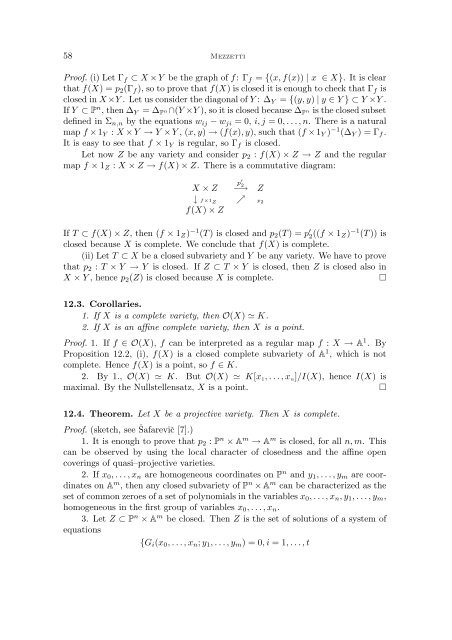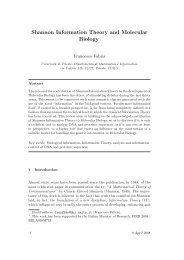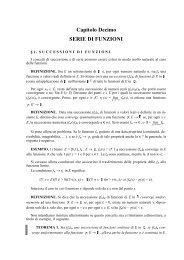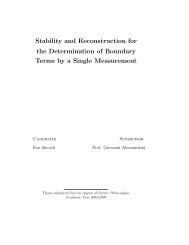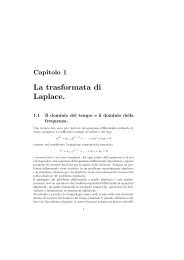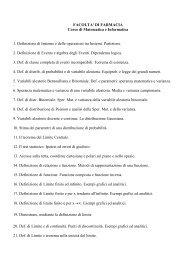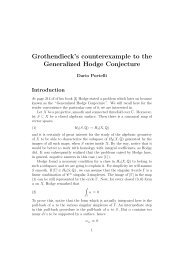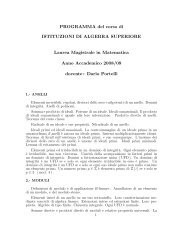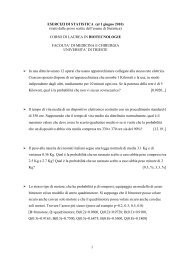INTRODUCTION TO ALGEBRAIC GEOMETRY Note del corso di ...
INTRODUCTION TO ALGEBRAIC GEOMETRY Note del corso di ...
INTRODUCTION TO ALGEBRAIC GEOMETRY Note del corso di ...
You also want an ePaper? Increase the reach of your titles
YUMPU automatically turns print PDFs into web optimized ePapers that Google loves.
58 MezzettiProof. (i) Let Γ f ⊂ X ×Y be the graph of f: Γ f = {(x, f(x)) | x ∈ X}. It is clearthat f(X) = p 2 (Γ f ), so to prove that f(X) is closed it is enough to check that Γ f isclosed in X ×Y . Let us consider the <strong>di</strong>agonal of Y : ∆ Y = {(y, y) | y ∈ Y } ⊂ Y ×Y .If Y ⊂ P n , then ∆ Y = ∆ P n∩(Y ×Y ), so it is closed because ∆ Pn is the closed subsetdefined in Σ n,n by the equations w ij − w ji = 0, i, j = 0, . . ., n. There is a naturalmap f ×1 Y : X ×Y → Y ×Y , (x, y) → (f(x), y), such that (f ×1 Y ) −1 (∆ Y ) = Γ f .It is easy to see that f × 1 Y is regular, so Γ f is closed.Let now Z be any variety and consider p 2 : f(X) × Z → Z and the regularmap f × 1 Z : X × Z → f(X) × Z. There is a commutative <strong>di</strong>agram:X × Zp ′ 2−→Z↓ f×1 Z ր p 2f(X) × ZIf T ⊂ f(X) × Z, then (f × 1 Z ) −1 (T) is closed and p 2 (T) = p ′ 2 ((f × 1 Z) −1 (T)) isclosed because X is complete. We conclude that f(X) is complete.(ii) Let T ⊂ X be a closed subvariety and Y be any variety. We have to provethat p 2 : T × Y → Y is closed. If Z ⊂ T × Y is closed, then Z is closed also inX × Y , hence p 2 (Z) is closed because X is complete.□12.3. Corollaries.1. If X is a complete variety, then O(X) ≃ K.2. If X is an affine complete variety, then X is a point.Proof. 1. If f ∈ O(X), f can be interpreted as a regular map f : X → A 1 . ByProposition 12.2, (i), f(X) is a closed complete subvariety of A 1 , which is notcomplete. Hence f(X) is a point, so f ∈ K.2. By 1., O(X) ≃ K. But O(X) ≃ K[x 1 , . . ., x n ]/I(X), hence I(X) ismaximal. By the Nullstellensatz, X is a point.□12.4. Theorem. Let X be a projective variety. Then X is complete.Proof. (sketch, see Šafarevič [7].)1. It is enough to prove that p 2 : P n × A m → A m is closed, for all n, m. Thiscan be observed by using the local character of closedness and the affine opencoverings of quasi–projective varieties.2. If x 0 , . . ., x n are homogeneous coor<strong>di</strong>nates on P n and y 1 , . . ., y m are coor<strong>di</strong>nateson A m , then any closed subvariety of P n × A m can be characterized as theset of common zeroes of a set of polynomials in the variables x 0 , . . ., x n , y 1 , . . ., y m ,homogeneous in the first group of variables x 0 , . . ., x n .3. Let Z ⊂ P n × A m be closed. Then Z is the set of solutions of a system ofequations{G i (x 0 , . . ., x n ; y 1 , . . ., y m ) = 0, i = 1, . . ., t


